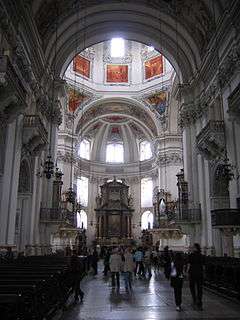Coronation Mass (Mozart)
| Missa brevis in C major | |
|---|---|
| "Coronation" | |
| Mass by W. A. Mozart | |
 Salzburg Cathedral, where the mass was first performed, probably on Easter Sunday | |
| Other name | Krönungsmesse |
| Catalogue | K. 317 |
| Occasion | Easter |
| Composed | 1779: Salzburg |
| Movements | 6 |
| Vocal | SATB choir and soloists |
| Instrumental |
|

The Krönungsmesse (German for Coronation Mass) (Mass No. 15 in C major, K. 317; sometimes Mass No. 16), composed in 1779, is one of the most popular of Wolfgang Amadeus Mozart's 17 extant settings of the Ordinary of the Mass. This setting, like the majority of Mozart's mass settings, is a Missa brevis, or short mass (as opposed to the more formal Solemn Masses or High Mass, known as Missa solemnis).
History
The mass in C major was completed on March 23, 1779 in Salzburg. Mozart had just returned to the city after 18 months of fruitless job hunting in Paris and Mannheim, and his father Leopold promptly got him a job as court organist and composer at Salzburg Cathedral. The mass was almost certainly premiered there on Easter Sunday, 4 April 1779. Contrary to a popular misconception, it was not intended for the church of Maria Plain near Salzburg.[1]
The mass K. 317 mass appears to have acquired the nickname "Coronation" at the Imperial court in Vienna in the early nineteenth century,[2] after becoming the preferred music for royal and imperial coronations as well as services of thanksgiving. Whether it was performed at the coronations of Leopold II in 1790 and Francis II in 1792, as some sources assume, is unlikely.
Musical allusions to this mass appear in the slow movement of the Symphony No. 98 and the Harmoniemesse of Mozart's contemporary, Joseph Haydn.[3]
The mass was performed in a liturgical context in St. Peter's Basilica in the Vatican on 29 June 1985, with Pope John Paul II officiating and Herbert von Karajan conducting the Vienna Philharmonic Orchestra, the Wiener Singverein and the Sistine Chapel Choir.[4][5]
Structure
The work is scored for SATB soloists and chorus, 2 violins, "Bassi", 2 oboes, 2 horns, 2 trumpets, timpani, 3 trombones (which reinforce the alto, tenor and bass) and organ. Notable is the lack of violas, typical of music written for Salzburg, and the vague name "basses" for the stave shared by organ, bassoon (specified only in the Credo), cello and double bass. Among the original parts is one for "violone", a slippery term sometimes implying a 16' bass but also used for the 8' bass violin.
The Kyrie, Gloria and Credo all begin with an engaging rhythm. The soloists contrast with the larger forces of the choir, often as a quartet. Of note in this regard are the central Adagio section of the Credo at "Et incarnatus est", and the surprise of the Benedictus after the chorus has already declaimed the "Hosanna". These musical breaks mimic what is occurring in the mass at these points. Rubrics require the congregation to change from a standing position to a kneeling position at the 'incarnatus' out of respect for the Incarnation of Christ: hence the musical break. Similarly, only the first verse of the 'Sanctus' is sung before the Consecration, the 'Benedictus' verse is required to be sung afterward, according to the rubrics of the Mass. This required rubrical division often results in the verses appearing in music as two separate movements, although they are thematically joined. In the Credo, Mozart introduces the trombones for the Crucifixus and using a chromatic fourth in the bass.[6] The soprano solo of the Agnus Dei exhibits melodic similarities to and may foreshadow "Dove sono", an aria of the Countess from Le nozze di Figaro.
See also
References
- ↑ Karl Pfannhauser, "Mozarts ‘Krönungsmesse’." Mitteilungen der Internationalen Stiftung Mozarteum 11, no. 3-4 (1963): 3-11
- ↑ Black 2007, pp. 198-243.
- ↑ Heartz 2009, p. 662
- ↑ Koo, Samuel (26 June 1985). "Von Karajan, Vienna Philharmonic To Join Pope in Musical Mass". Associated Press. Retrieved 1 October 2014.
- ↑ "Papst Johannes Paul II zelebriert feierliches Hochamt im Petersdom mit ...". Library of Congress. Retrieved 16 May 2017.
- ↑ Jasmin Melissa Cameron (2006). The Crucifixion in Music: An Analytical Survey of the Crucifixus between 1680 and 1800 Contextual Bach Studies No. 1, The Scarecrow Press, Inc. p. 193
Sources
- Daniel Heartz (2009). Mozart, Haydn and Early Beethoven: 1781 — 1802 New York: W. W. Norton & Co.
- David Ian Black (2007). Mozart and the Practice of Sacred Music, 1781-91 (Ph. D. thesis). Harvard University.
External links
- Missa in C KV 317: Score and critical report (in German) in the Neue Mozart-Ausgabe
- Free scores of the Coronation Mass, KV 317 in the Choral Public Domain Library (ChoralWiki)
- Mass in C major, K.317: Scores at the International Music Score Library Project (IMSLP)
- Download in OGG format (Creative Commons Licence)
